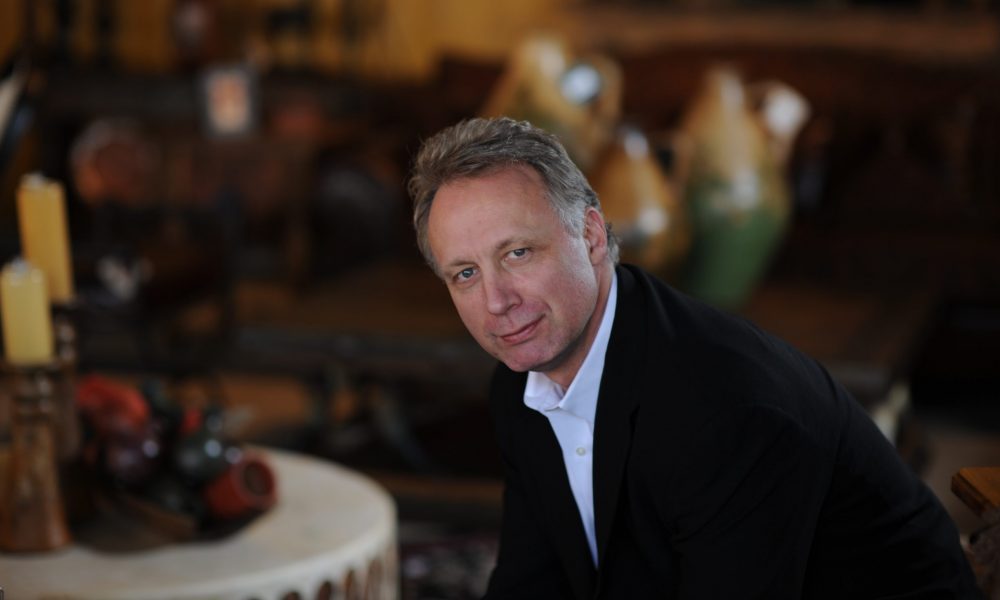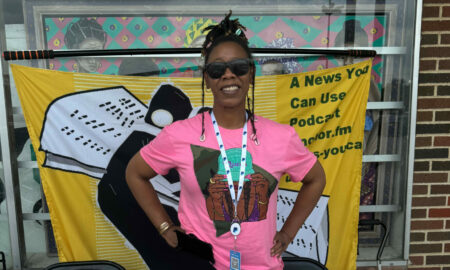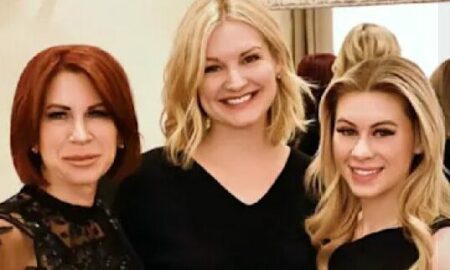

Today we’d like to introduce you to Dr. Phillips Kirk Labor.
So, before we jump into specific questions about the business, why don’t you give us some details about you and your story.
Interestingly, my story, about how I chose to become a Physician and an Ophthalmologist, in particular, began when I was just a toddler and in many ways, might be seen as having been pre-determined. This assumption becomes evident when I share that as a toddler, the first word I ever said was the word “see” and then later, in the third grade, my science project for school was “How the Eye Works”. In later years, my interest in Ophthalmology led me to work as a Physician’s Assistant for a very well-regarded Ophthalmologist in New Orleans before I entered Medical School. So it appears as though, for reasons I’m at a loss to explain, I’ve always had an interest in eyes and vision.
I was born in the small East Texas town of Pittsburg but other than a few early years in Southern Michigan, a year abroad in Denmark and a summer in Boston, Massachusetts spent most of my life in Shreveport, Louisiana. My father is a retired English Professor from Centenary College of Louisiana in Shreveport where he spent nearly 60 years teaching; he specialized in American Literature and is widely recognized as the world’s foremost authority on Jack London. It was through his interest in Jack London that led to him receiving an invitation to teach at Harvard for a summer and to his receiving a Fulbright Grant to teach in Aarhus, Denmark from 1973 to 1974.
While my father is certainly a “doctor” (a PhD), other than my Great Grandfather, who was a country doctor in Southeast Oklahoma, there has been no one else in my family involved in Medicine. Nonetheless, it was my parents who suggested to me, after noticing my compassionate personality early in my life, that I might enjoy a career in Medicine.
After finishing my first year of High School in Europe, I graduated from Byrd High School in Shreveport and attended Centenary College from which I received a BS in Biology and a BA in Chemistry in 1982. Subsequent to that, because I had no real experience in the field of Medicine, I chose to go on to Physician Assistant School at the University of Texas Medical Branch at Galveston where I graduated in 1985. I chose PA School in order to help me better understand whether or not a professional life in Medicine was something that truly interested me. I found that I really enjoyed it and considered applying immediately to Medical School but a job offer came about working in the field of Ophthalmology and I decided to investigate this first. I had been offered an externship working for two Ophthalmologists in Lafayette, Louisiana; they were brothers and practiced General Ophthalmology with an emphasis on cataract surgery.
During this period, my interest in vision and how the eye works really became manifest. Before I accepted the externship position, it had been explained to me that if things worked out, the Ophthalmologists in Lafayette had a cousin, also an Ophthalmologist, in New Orleans who might be interested in hiring a Physician’s Assistant for his practice.
The time I spent in Lafayette did work out favorably for me and I decided to take the job in New Orleans. My acceptance of the position in New Orleans turned out to be a key decision for me and one that would ultimately lead me to become an Ophthalmologist.
The opportunity in New Orleans was with a very well-known and leading Ophthalmologist named Robert F. Azar. I was only just competent in the world of Ophthalmology and had much to learn; to his credit, Dr Azar took me under his wing and began to educate me in the nuances of the practice of Ophthalmology. I was with him for nearly two years and it was during this time that I learned quite a bit about this discipline of Medicine; I was so intrigued by it that my desire to attend Medical School and get into Ophthalmology was essentially solidified by this experience. The time I spent in this practice was a seminal event in my life and I will be forever indebted to Dr Azar for hiring me back in 1985. In retrospect, I’m not sure I’d be an ophthalmologist now if I had not taken this route to my current position as a physician and in fact to this day, still draw on my experiences while working with Dr Azar as I practice Ophthalmology. Having been exposed to Dr Azar as well as his associate surgeons, Dr Dara Stevenson and Dr Jeanine Scheinhorn and with their encouragement, I applied and was accepted into Medical School at Louisiana State University School of Medicine in Shreveport.
I entered Medical School in the late summer of 1987, graduated 4 years later, in June 1991 with my Doctorate of Medicine (MD) degree and spent one added year at LSUMC School of Medicine in Shreveport during my Internship. While I was in Medical School I was invited to join the Alpha Omega Alpha Honor Medical Society. From its website, AOA is a professional medical organization which recognizes and advocates for excellence in scholarship and the highest ideals in the profession of medicine. Alpha Omega Alpha (AOA) is to medicine what Phi Beta Kappa is to letters and the humanities and Sigma Xi is to science. Its values include honesty, honorable conduct, morality, virtue, unselfishness, ethical ideals, dedication to serving others, and leadership.
Members have a compelling drive to do well and to advance the medical profession and exemplify the highest standards of professionalism. I was honored to have been asked to be a part of this organization and try to live up to its standards each day as I practice Medicine. Once I completed Medical School I had one year to fill as an Intern prior to beginning my Residency in Ophthalmology. As an individual who “matched” (the process whereby Medical Students are “matched” with a particular training program in his or her chosen field of Medicine…this process occurs in the Spring of a Medical Student’s senior year and is simply referred to as “The Match” and my “match” occurred with The University of Alabama at Birmingham/Eye Foundation Hospital Combined Program in Ophthalmology) in Ophthalmology, I was afforded a choice of what discipline of Medicine I’d like to learn during my one year (July of ’91-June of ’92) of Internship training. In my case I elected to do my Internship training in Internal Medicine because so many systemic (meaning involvement of the entire human body in some manner) illnesses manifest themselves with findings in the eye(s).
In fact, the eye is the only organ of the entire human body which allows a physician to directly investigate the cause of an illness without having to put a tube into it, make an incision in it, scan it or otherwise do something to visualize some aspect of the human anatomy; we can investigate what might be going on elsewhere in the body by simply looking at the external surface of the eye, looking at or through the cornea (the clear dome of tissue overlying the iris and pupil) or through dilation of the pupil allowing us to see more deeply into the back of the eye (an ophthalmologist may be able to tell what kind of medicine you’re taking, what kind of systemic illness you may have or how severe it might be; diabetes is just one of many examples of this ability).
Throughout this year I was exposed and learned to treat many systemic illnesses that I would encounter later during my Residency and later still in private practice. Those illnesses ran the gamut of diseases from heart disease to infectious diseases such as tuberculosis and HIV to diabetes and more; the experience was invaluable in helping prepare me for Residency and become a better-rounded ophthalmologist.
My Residency would expose me to the fundamentals of Ophthalmology and how to care for patients with eye issues both medically and surgically in more extensive ways than my previous employment as a Physician’s Assistant. Residency training allowed me to experience every aspect of ophthalmology, from Pediatric Ophthalmology to Neuroophthalmology to diseases of the retina and more. It was through these experiences that I really developed my primary interest in cataract and Refractive surgery. More than this though, the time I spent in Residency training granted me a life-altering experience that I believe has helped me to become a more compassionate and understanding physician.
Until this event, I had been extremely healthy other than a bout of double pneumonia as a child and an occasional encounter with the Flu and the run-of-the-mill head cold. This claim came to an end while I was a Resident Physician when I became very ill. In early February of 1994, I developed symptoms I initially thought were consistent with the Flu but which later revealed themselves to be a consequence of something much more ominous and life-threatening; through the diligent observance and diagnostic acumen of my Attending Ophthalmologist at the time, an extremely intelligent Neuro-Ophthalmologist named Dr Lanning Kline and an Infectious Disease Specialist, Dr Frank Griffin, I was found to have a heart murmur due to a congenital heart defect I never was aware I had which led to the development of an infection inside my heart.
This infection, known as bacterial endocarditis, is almost universally fatal without proper treatment. I was admitted to the hospital at The University of Alabama at Birmingham (at the time, I had learned through my earlier training and reinforced after beginning my Residency training there, one of the top heart centers in the nation) where I received intensive antibiotic therapy which continued for a full month after my discharge to kill the offending bacterial organism (in my case, a type of Strep) and re-sterilize my blood. The treatment was successful, in no small measure due to the amazing care I received from one of the best Cardiologists in the world, Dr Cecil Coghlan, but not before the bacteria had damaged one of my heart valves (my Mitral valve) which would require true “open heart” surgery to correct.
Fortunately for me, one of only a handful of Cardiothoracic Surgeons (Dr Albert Pacifico) in the entire country was on Staff at UAB; Dr Pacifico agreed to take on my case. The surgery to repair my valves (my Aortic valve was also involved as the instigating site of the infection) took place on October 28th of the same year and was deemed a resounding success. I was very fortunate and subsequent to that time was able to complete my Residency training and go forward with my life normally without any restrictions in my activity.
Since that event, I’ve come to believe my life was guided in a way that caused me to match in my ophthalmology residency at Birmingham and that Divine Intervention played a role in this part (and probably others throughout my life) of my personal history. By definition I had had this congenital heart defect since birth and therefore could’ve become ill at any time up until February of 1994 when I just happened to be in training at a hospital where all the necessary ingredients were in place for me to be treated successfully; at nearly any other place in the country, things may not have turned out so fortuitously for me. This turn of events created an environment for me to become a patient and experience first-hand, what it is like to entrust one’s medical care to a stranger(s). For this reason, I feel as though I have a unique perspective when it comes to the anxiety and concerns that accompany a patient when it comes to placing one’s self in the care of a physician. This also drives me to be perfect with each and every patient I come in contact with and to impress the same impetus toward perfection in my Staff.
While it is difficult to attain perfection in Medicine for a variety of reasons (the individual healing response being chief among them), the goal is certainly one that we strive for. Furthermore, it was during this difficult time that I was able to reflect on the things in life that meant the most to me.
One of those things was the woman I was seeing at the time and without whom I would not have been able to accomplish many of things I have. That person was Dr Penny Megison, MD who, at the time, I was dating long-distance. Dr Megison was someone I had met while in Medical School and who was in her Residency training to become a Diagnostic Radiologist at LSU School of Medicine in Shreveport. She would later go on to extend her training by going through a Radiology Fellowship in Body Imaging (further study through CT Scan/Ultrasound/MRI of the chest, abdomen and pelvis areas of the human anatomy) at The University of Texas Medical Branch at Galveston. Dr Megison would leave her Residency training program to be by my side through many of the more difficult times I faced while I was stricken with endocarditis (to include my open heart surgery). It didn’t take much reflection to know that this was the woman I wanted to spend the remainder of my life with and in due course I proposed to her. Dr Penny, as she came to be known, accepted my proposal and was smart to set our date for marriage to be the same day of the month on which I had my surgery…better for me not to forget our anniversary! That was in 1995; we’ve been together ever since.
I was able to complete my Residency training and took my first job as an Ophthalmologist in Arkansas where I was able to experience a very busy practice with a very large Optometric referral base; this was something I had seen before while in practice as a Physician’s Assistant but this was on a much greater scale. During this initial foray into private practice ophthalmology it became even clearer to me that this type of arrangement was beneficial for the doctors involved but even more so for the patient. The reasons for this are multiple but a significant one is that it is patient driven and the patient makes the choice to return to the doctor who, in many instances, has been his/her eye doctor for years. It was here, in this setting, that I also began to come to the realization that practicing in a group setting might not be ideal for me.
While the idea of setting up my own practice was still a nascent one at this point in my career, the seeds that had been sown as a Physician’s Assistant working in the Ophthalmology practice in New Orleans were definitely beginning to germinate. Nonetheless, I fulfilled the terms of my three year contract in Arkansas and I left there for a bigger group practice in Fort Worth.
In 1999, I began practicing in Fort Worth in a practice that contained approximately 10 Ophthalmologists and two Optometrists and several satellite locations. My stint in this practice lasted several months before I was forced to leave due to an illness in my wife’s family. Because of this, after only a few months in Fort Worth, we re-located back to Shreveport to be close to her mother who, it was thought at the time just prior to us returning, had a terminal illness. Instead, she made a remarkable recovery and as a consequence of our move, I spent two years in another group practice albeit a smaller one than the one I had left in Fort Worth. It was while I was in Shreveport that I furthered the relationships I had with the Optometric community, setting up two satellite offices in smaller towns outside of Shreveport with the assistance of Optometrists in those communities. While the time in Shreveport was important with respect to our family ties as well as learning the business of Ophthalmology, my efforts to grow my practice within the confines of another group practice were limited. This was due, in part, to the philosophy of the group but also as a result of a more depressed economy in that area. For these reasons, now reassured that my wife’s mother was in better health, we agreed we should return to the DFW Metroplex. It was subsequent to returning to this area and returning to the group practice I’d been in previously, that it became fully evident I needed to be in practice on my own.
In January of 2002 I took out a large loan from the bank and started Eye Consultants of Texas (ECT) and later, LoneStar Ambulatory Surgery Center (LSASC), The Eye Consultants Research Foundation (ECRF) and The Dry Eye Institutes of America (DEIA) followed shortly thereafter. I began the practice at that time with the help of Dr Cary Labbe, an Optometrist practicing in Mineral Wells, who I had met while I was in the larger group in Fort Worth. Dr Labbe’s willingness to work with me as I started out was instrumental to the success of the practice and I have been grateful to her as a catalyst for the success of ECT. She had been in practice in Mineral Wells (now Graham) for many years and her support helped start Eye Consultants on its way to becoming the success it has become thus far; the growth of the practice would not have proceeded at the rate it did without her help. Just prior to returning to DFW my wife and I had decided we would reside in Southlake (in large measure this was dictated by the terms of my agreement with practice I returned to) and therefore I should begin my start-up where I found office space in Grapevine with a satellite office, through Dr Labbe’s generosity and support, in Mineral Wells.
While I didn’t realize it at the time, I was to become the first full-time, Optometry-supportive, Ophthalmologist in the area and only the second full-time ophthalmologist to both reside and practice in the Grapevine/Southlake area. In light of this fact, at least in part, I became busy very quickly and soon had patients lining up outside my door to see me. This was both a blessing and a curse; a blessing in that I had that kind of interest from patients coming to see me but difficult when it came to managing that kind of patient volume. Through the years I have come to learn that managing patient time is nearly as important as performing great surgery. A patients’ time is very valuable and so learning to manage this temporal characteristic of a practice while providing excellent care is important in establishing a good patient-doctor relationship. However, what I have also come to realize is that many people have limited understanding for what is required of an Ophthalmologist, as compared with a General Practitioner as an example, to acquire information to offer complete care. In other words, a visit to an Ophthalmology practice is more “testing intensive” than many other disciplines of Medicine when it comes to gathering the data needed to treat a patient; this in turn, means office visits with an Ophthalmologist tend to be longer than they are with other types of medical doctors.
This has been a constant management consideration as the practice has grown. Indeed, as time went on and the practice in Grapevine/Southlake continued to grow, I was forced to withdraw from the practice in Mineral Wells and begin seeing patients closer to home and my primary practice in Grapevine/Southlake.
The growth of Eye Consultants of Texas in the DFW metroplex and the need to spend more time in my Grapevine/Southlake location led me to establish satellite offices in Fort Worth as well as in Weatherford. In Fort Worth, I established a site in conjunction with a highly respected Vitreoretinal specialist, Dr Harry Rosenthal; in Weatherford, my relationship with Optometry proved beneficial when Dr Tom Annunziato offered his office space as a place for me to see patients I had traditionally been seeing in Mineral Wells and the surrounding area. One of the attributes of the practice and one of the reasons I was able to grow the practice more quickly has stemmed from the Optometric relationships I had established (and continue to establish through the present time). Dr Tom Annunziato proved to be an important colleague to have through the early years of the practice. In addition to being a great doctor to work with; Dr Annunziato has been a leader in the Optometric community. He has led his profession through his Presidency of the Texas Optometric Association as well as having been named the area’s top OD on a number of occasions which in turn helped me to further develop my connections with Optometry. As a result of my association with Dr Annunziato, I was granted access to a population of patients I might not otherwise have come in contact with, facilitating even greater growth of the practice. My years of experience working with Optometry as a Physician’s Assistant and as an Ophthalmologist in urban as well as rural areas in particular, provided the impetus for me to support Optometry in their Legislative efforts to be able to provide more medical care to patients especially in geographic areas where getting to an Ophthalmologist would’ve been difficult. This helped to solidify my relationship to Optometry and set the stage for further growth of the practice. In fact, by 2010, after having moved from my original cramped office space just a couple of years previously, I was able to open a new 17,000 square foot Eye Consultants of Texas clinic and surgery center (LoneStar Ambulatory Surgery Center) in Grapevine/Southlake where the practice currently resides.
Throughout this period I continued to pursue my professional and personal goals and was privileged to be invited to become a member of an organization known as The Society for Excellence in Eyecare (SEE) where I currently serve as President and Board member. SEE is an organization made up of many of the top Ophthalmology practices from around the country and as its website describes, it exists as the patient’s advocate; the Society for Excellence in Eyecare (“SEE”) promotes quality, safety, and cost-effective care of the eye. Members of the Society for Excellence in Eyecare are leaders and innovators in their profession who are committed to the belief that they can best promote the interest of their patients through a cooperative effort, and by providing support for each other through the development and exchange of best practices, both clinical and administrative, and through peer review advocacy. In addition to SEE I was asked to become a member and ultimately a Board member of another highly regarded ophthalmic organization known as The American College of Eye Surgeons (ACES) through which I was able to further my training and certification as a qualified eye surgeon through The American Board of Eye Surgery (ABES). ABES is a purely voluntary certification process that has, as stated on its webpages, as its fundamental objective, to ensure relevant and appropriate criteria to permit the identification and recognition of valid and accepted standards of quality and competency for eye surgery.
The American Board of Eye Surgery promotes the highest possible quality ophthalmic surgical care through a certification program which includes, as one of its components, a process through which the surgeon’s surgical skills and judgment are tested and observed by his or her peers. I have strived to become highly qualified as an eye surgeon primarily as a means to ensure I’m providing the best care possible for my current and future patients; there is no higher calling for me professionally than to serve my patients to the utmost of my abilities. This has been reflected in the way I strive to instill the ideal of excellence when it comes to the people who work around me and goes back to the time when I was a patient in the fight for my life. To this end I continued to surround myself with other like-minded people through other organizations such as The American-European Congress of Ophthalmic Surgeons (ACEOS), The American Society of Cataract and Refractive Surgery (ASCRS) among several others. My involvement in these organizations and others like them have provided me the opportunity to continue to learn new techniques and learn about new technologies which I’ve been able to bring to the practice and into the DFW area (the ORA system for use during cataract surgery and which gives surgeons the opportunity to make last minute changes regarding the Intraocular Lens Implant power is just one example). In furtherance of my desire to provide the best care possible to my patients and the patients of Eye Consultants of Texas, I created the Eye Consultants Research Foundation (ECRF) which allows us to run clinical trials out of the practice. This has led to our involvement with new technologies, oftentimes while they are going through the FDA approval process, which then gives us an ability to acquire this newer technology to our patients sooner than might otherwise be possible. Recently we went through a government mandated FDA audit for a new technology intraocular lens (IOL) implant, the Rx-Sight Light Adjustable Lens or LAL, which, once it receives FDA approval, will give the cataract surgeon the ability to adjust the power of the implant, to include astigmatism-correcting power, after the IOL has already been inserted into the eye. This represents a tremendous advantage for patients who may be able to attain 20/20 or better vision routinely after cataract surgery. There are several other exciting technologies and advancements in care that Eye Consultants and its related entities (e.g.: The Dry Eye Institutes of America or DEIA, Eye Consultants Research Foundation, ECRF) have been able to become involved with due to our Clinical Research capability. In fact, we have evaluated several new treatment modalities for this issue and are currently working on another study for treatment of Dry Eye Syndrome.
As the practice has grown and as I have grown professionally, opportunities that may have been less accessible through other practice climates have been made manifest and presented further opportunities for growth in the world of eye care. Apropos of this, several years ago I became more aware of the issue ocular surface disease and the effect it was having on my patients in their activities of daily life. Ocular surface disease comes in many forms but most notable to me were the numbers of patients I was seeing with issues related to dryness of the eyes. This condition, known as Dry Eye Disease (DED) or Dry Eye Syndrome (DES) led me to establish the Dry Eye Institute of America in an effort to provide patients better care for this, oftentimes, debilitating eye condition.
Despite the growth of the practice I managed to find time to do Medical Missionary work overseas through the International College of Surgeons (ICS), where I’ve served as Vice President, in Northern Iraq (Kurdistan). Through my education in Medical School I met Dr Gazi Zibari, an Iraqi Kurd and upper level surgery resident who had immigrated with his family to the United States during the initial chemical gas attacks against them in the mid-70’s by Saddam Hussein. Dr Zibari arranged for a medical team to travel to his hometown of Duhok in Northern Iraq to provide care there and in the surrounding towns and cities in Iraqi Kurdistan. I felt privileged to have been asked to accompany his team during several of these trips as the only Western ophthalmologist to have visited this area of Iraq in many years. During these trips I began to realize the power and prestige that American Medicine projects around the globe and especially in underserved areas of the world. I count these trips as some of the most fulfilling work of my career to date and while the business of my practice has prevented me from returning lately, I look forward to being able to return in the near future.
In closing, the history of the growth of my businesses, as I see it is still in its infancy and I, along with my Staff continue to work to make the practice better with the primary goal of providing the best, most advanced eyecare to the people of the Dallas-Fort Worth area possible.
My own medical history has given perspective as a patient that many others may not have and that serves as a strong motivator for how I approach each and every patient. Furthermore, it is my hope that as the practice continues to grow and evolve, I will be able to extend that care to others throughout the world.
Contact Info:
- Address: 2201 Westgate Plaza, Grapevine, TX 76051
- Website: www.eyectexas.com
- Phone: 817-410-2030
- Email: plabor@eyecontx.com






Getting in touch: VoyageDallas is built on recommendations from the community; it’s how we uncover hidden gems, so if you know someone who deserves recognition please let us know here.

















